Double-sided altarpiece (1330?)
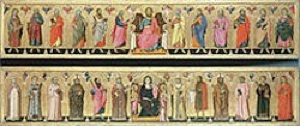
This altarpiece, which is attributed to Meo di Guido da Siena, came from the high altar. The inscription records that it was commissioned in 1333, "in the time of Abbot Ugolino". This was possibly Ugolino di Nuccio da Montevibiano, who was abbot in the period 1330-57. However, it seems that the date was originally given as 1330, in which case it was commissioned by Ugolino Vibi Guelfoni da Gubbio, who was abbot in the period 1305-30.
-
✴One side of the altarpiece depicts the Madonna and Child enthroned with angels, flanked by saints whose relics the monastery possessed. The donor, Abbot Ugolino is portrayed in his white Benedictine habit, kneeling at the foot of the throne.
-
✴The other side of the altarpiece depicts Christ enthroned, flanked by the twelve Apostles.
The altarpiece was probably removed from the high altar in 1436. Its two sides, which were separated in the 18th century, remained at San Pietro until the 1830s. They are now in the Städelsches Kunstinstitut, Frankfurt.
SS Benedict and Rufinus (1492)
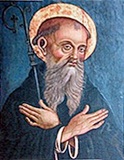
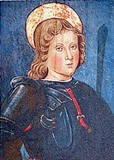
St Benedict St Rufinus of Amandola
These two small panels at the beginning of the west wall of the cloister (i.e. turn right and then left from the entrance to the first floor) have recently been related to payments made by the monks of San Pietro in 1491-2 to Ludovico d’ Angelo. They are now in the Galleria Tesori d’ Arte.
Each panel is now in a gold-figured frame that probably dates to the 17th century. St Rufinus, who is depicted here as a young man in armour, is the saint whose relics are preserved in the crypt of the Benedictine Abbazia di San Rufino e Vitale at Amandola, Marche. Before the link with the documents mentioned above was made, this saint was often thought to be either St Michael or St George.
San Pietro Polyptych (1495-1500)
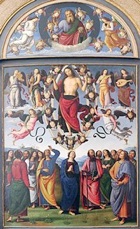
The altarpiece was removed and dismantled in 1608, during the re-modelling of the church. From this time, the main panel of the Ascension was hung in the apse, and the other panels were distributed within the church. The probable reconstruction of the original disposition is illustrated in this page in Wikipedia.
Napoleon's commissioner, Jacques-Pierre Tinet selected most of the panels (except five predella panels of saints that escaped his attention) for confiscation in 1797, and they were sent to Paris. They were subsequently dispersed:
-
✴The main panel of the Ascension of Christ was sent to Lyon in 1811 and is now in the Musée des Beaux Arts, Lyon.
-
✴The lunette of God the Father with angels was installed in the Parisian church of St Gervais in 1811. It was reunited with the main panel in the Musée des Beaux Arts, Lyon in 1952.
-
✴Tondi of the prophets David and Isaiah, which possibly came from protective doors that covered the altarpiece, were sent to Nantes in 1809 and are now in the Musée des Beaux Arts, Nantes.
-
✴The predella panels of the Adoration of the Magi, the Baptism of Christ and the Resurrection were sent to Rouen in 1803 and are now in the Musée des Beaux Arts, Rouen).
-
✴Antonio Canova recovered the predella panels of SS Benedict, Placidus and Justina (the patron saint of the Cassinese Congregation) in 1815, when they were secured for the Pinacoteca Vaticana, Rome.

Predella panels of SS Scholastica (the sister of St Benedict); Herculanus; Peter Abbot (the founder of San Pietro); Constantius; and Maurus remained in San Pietro until 1811, when Agostino Tofanelli secured them for the Musei Capitolini, Rome. They were returned to Perugia in 1815 and are now in the sacristy.
Panels attributed to Raphael
Two panels that were (somewhat dubiously) attributed to Raphael, were confiscated from the church by the French in 1797 and subsequently lost. They depicted:
-
✴the Pietà; and
-
✴the Madonna and Child with angels.
In recompense, the monks were given (in 1816) a panel of the Pietà by Perugino that is now on the altar of the 5th bay of the left aisle.
St Benedict in glory (ca. 1600)
This panel from the Cappella delle Reliquie, which attributed to Benedetto Bandiera, is now in the Aula Magna of the Fondazione per l’ Istruzione Agraria.
Annunciation (17th century)
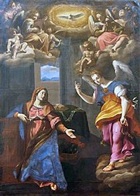
Immaculate Conception (ca. 1650)
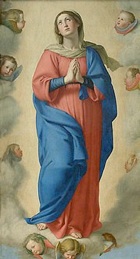
SS Peter and Paul (1825)
Abbot Vincenzo Bini commissioned this panel for the Cappella del Sacramento from Jean-Batiste Wicar in 1825, just before he left Perugia to take up his post as Procurator General of the Cassinese Congregation. The panel was placed on the altar so that part of the fresco of the Madonna del Giglio (see above) could be seen through an annular opening between the standing figures of the two saints. The panel has recently been removed.
San Pietro: Main Page Exterior Church Interior
Crypt, Chapels and Sacristy Art from San Pietro
Return to Monuments of Perugia.
Return to Walk IV.



